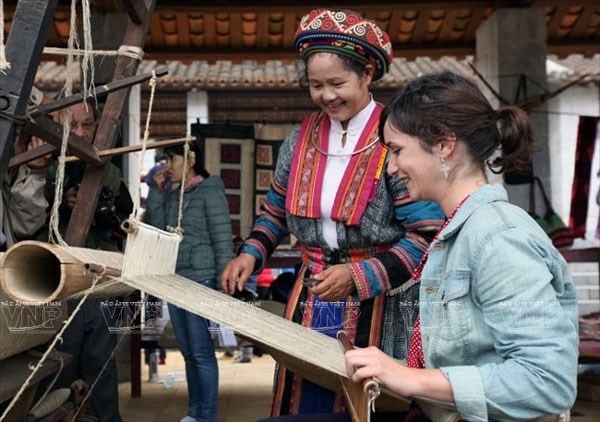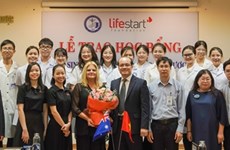The Mong, and the fabric of their life
Making beautiful garments with flax has for long been a way of life for the Mong; now, it is offering them a stable livelihood.
 Tricky technique: A foreigner tries weaving linen cloth with a traditional loom of the Mong people (Source: VNA)
Tricky technique: A foreigner tries weaving linen cloth with a traditional loom of the Mong people (Source: VNA) Linen has been the fabric of life for the Mong people in Ha Giang province for a long, long time.
The ingenuity of this ethnic minority in making this fabric from scratch, dyeing it with different colours using no chemicals, and making beautiful garments has turned every Mong woman into a colourful flower blooming amidst the rocky mountains they call home.
In the past, most linen garments, which take years to finish, were tailored for members within just one family, but over the years, as more people discover the beauty of the fabric and the work done on it, a joint effort is being made to widen its reach.
The Hop Tien Linen Co-operative in Lung Tam village, Quan Ba district, is one of the spearheads of this effort, and it has succeeded in marketing the linen garments to the lowlands and beyond the country’s borders.
“Linen is the treasure of Lung Tam village,” said Vang Thi Mai, who heads the co-operative. “Throughout Ha Giang province, as long as there are Mong People, there will be linen. However, it is Lung Tam village that has succeeded in preserving, promoting and making our traditional products flourish.”
At present, the co-operative has 130 traditional looms, creating jobs for 135 people, both villagers and others in the vicinity. All its nine production groups are based in Lung Tam, with every household getting involved in one stage or other of the production process.
“Mong people in the village are very happy and not anxious anymore, because our traditional job has been successfully restored and developed, and we are able to introduce one of our culture to both domestic and international friends,” Mai said.
The Hop Tien Co-operative makes more than traditional clothes. Using the traditional textiles and patterns that have been passed down from their ancestors, they have creatively produced a variety of modern household decorative items like pillow cases, wallets, curtains and tablecloth.
Making the fabric is a lot of work. Mai said the whole process includes more than 21 stages, all of which are done manually.
First, the flax plants are planted and tended on the most fertile farmland. They are harvested after over two months and dried to make threads. When splitting the threads to get the sheaths, the Mong woman has to be extremely careful in order to acquire threads of the same lengths and not break them halfway.
The flax sheaths, bound in sheaves, will be crushed in stone mortars to soften them, until only the tough threads remain. These will be bound once again to make longer threads. After boiling them several times in water mixed with ash and bee wax, the linen threads become softer and whiter. This is when the Mong women bring their looms into play.
The cloth that is woven will be washed again to whiten them as much as possible. The next step is spreading the cloth on to logs and flattening them with flagstones that have been scraped with bee wax.
The colouring stage is also a meticulous process. The cloth is dyed with natural colours of extracted from local plants. In order to get the correct shade of indigo black, the weavers have to dye the cloth several times over several days. The cloth is submerged in the dye for about an hour, drained and submerged again. This happens five to six times, or even more.
The colours of the cloth are determined significantly by weather conditions. If it is sunny, it takes from three to four days to finish dyeing the cloth, but if it rains, the process can take up to two months.
“Despite all the hardship, it is the natural colours and handmade production that make our products unique,” Mai said.
Reviving a tradition
Mai says every member of the Hop Tien Co-operative has worked hard and dedicated themselves to the success of restoring the community’s traditional skill.
Having been the chairwoman of the commune women’s association for more than 20 years (1989 – 2006), Mai understands well the difficult lives that Mong women have experienced.
“The villagers used to live in great poverty. No matter how hard they worked, both at home and on the farm, they were still poor,” the 54-year-old artisan recalled.
“Mong women are not only industrious but also skillful. At the age of 13, besides helping their families work on the farm, they have been able to spin, weave, embroider or sew. I thought, why we can’t we weave our fabric to sell to others and better our lives?”
The traditional weaving tradition of the Mong was struggling against the appearance of modern clothes in their markets towards the end of the 1990s. Young girls did not stick to the habit of working on the looms like their ancestors and fewer women were wearing their traditional, homemade dresses. The skill of weaving, passed through generations, faced the risk of disappearing.
Wanting to preserve the cultural treasures of her community and to improve their living standards, Mai, with the support of her husband, encouraged other villagers to contribute funds to establish and join the Hop Tien Linen Weaving Centre, which was set up in her house in 1998. There were barely 10 members then.
In 2000, Mai received support from a project aiming to preserve and develop traditional craft villages, launched under a cooperation programme between Vietnam and Sweden.
A year later, in 2001, her efforts received another boost when the local People’s Committee allocated land for setting up the Hop Tien Linen Weaving Co-operative, enabling the construction of a workshop, helping stabilising production.
Soon, Mai realised that it was not enough to produce, the products had to be marketed.
“At first, I travelled down the mountains alone, bringing the products along with me, to join many trade fairs in Hanoi and introduce them to potential customers,” Mai said.
The opportunities to visit various souvenir, art and handicraft shops made her more aware of what the market demanded, what would sell.
“We needed to make many more products of better quality, adding souvenir items like scarves, handbags and tablecloth.
“International visitors, particularly those from Japan, French and Canada, enjoy our line of products and their indigo colour.”
Many of them have travelled long distances to reach Lung Tam village and signed long-term contracts with the co-operative.
Outside support
To sustain its growth, the Hop Tien Cooperative has collaborated with the Centre for Development Support of Vietnamese Trade Villages and Craftlink (a not-for-profit organisation seeking new markets for traditional artisans) to promote and introduce their linen to international markets.
The demand for the linen products of high quality and unique patterns increased rapidly, together with the number of villagers joining the cooperative.
A cooperation agreement with Association Batik International, a French organisation focusing on vocational training, has opened a new page in the development of the co-operative. Under the agreement, its members have the opportunity to get more training and enhance their skills, enabling them to make products more beautiful and of higher quality.
At present, the co-operative’s traditional linen products are sold in souvenir stores throughout Vietnam, including in prestigious hotels like Nikko and Horison. They are also found in some outlets in France, Japan, Canada, Britain and Switzerland.
Co-operative members are happy to see their traditional skill thrive and happier that it provides them with a decent income.
“Working in the co-operative provides me with a stable income of about 2.3 million VND (approximately 100 USD) per month after harvest,” said Sung Thi Mi.
“I do not have to travel far to work anymore and my children can attend school.”
The best news is that more and more Mong girls have become interested in weaving, and this enables them to support their families financially.
Hang Duong Thanh, vice chairman of the Quan Ba District People’s Committee, said the administration was taking the first steps towards developing community-based tourism in Lung Tam village.
“This will offer an opportunity for visitors to experience local life as they discover the Ha Giang Stone Plateau.
“Traditional linen products of the village will become souvenirs that travel to different countries, bearing features of highland cultures.”-VNA













